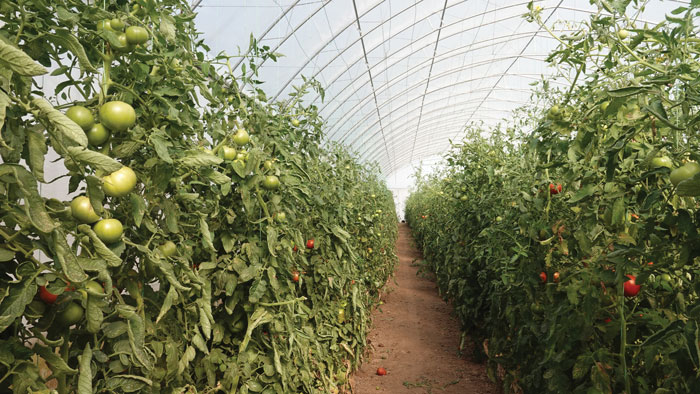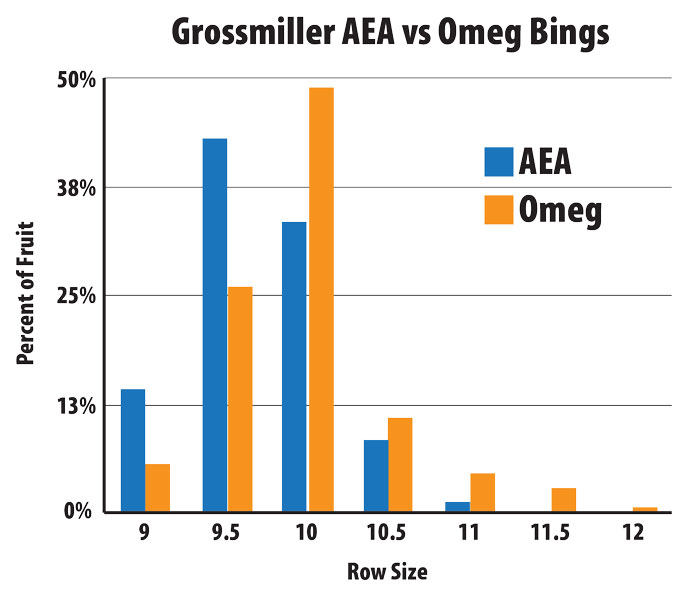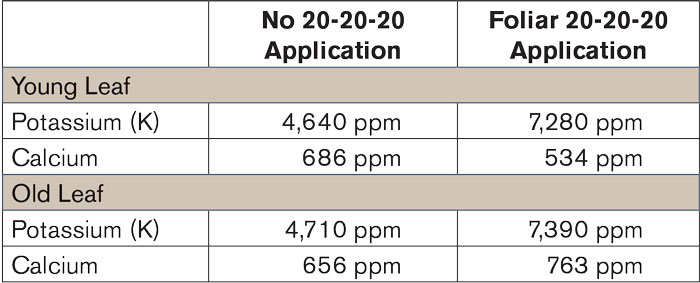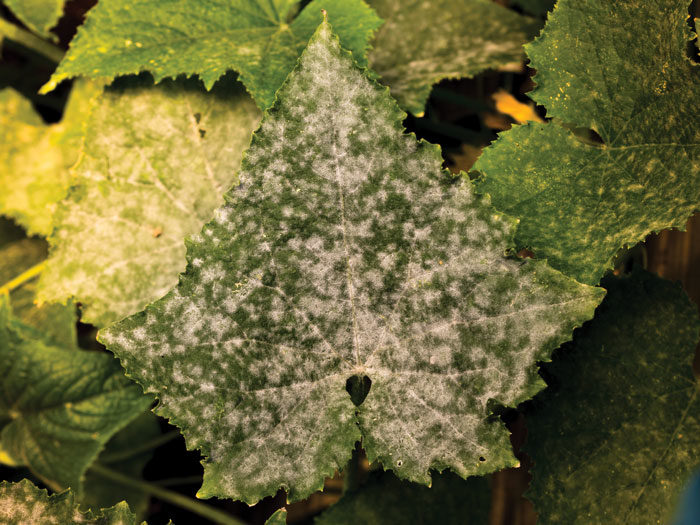What if you could decrease your nitrogen (N) and potassium (K) applications — anywhere from 30-70% — while increasing yields and crop health? That’s what John Kempf found from managing nutrition properly on many of the farms he works with, thanks to plant sap analysis.
The owner and founder of Advanced Eco Agriculture (AEA), a crop consulting and specialty plant nutrition and biological products company, turned to plant sap analysis after growing frustrated that dry matter-based tissue test results were not correlating to what he was seeing in the field. After trying plant sap analysis, he quickly discovered that this new nutrient-testing technology out of the Netherlands provided a much more accurate picture of what was happening inside the crops and can save growers thousands of dollars in fertilizer costs.
Plant Sap Analysis 101
Plant sap analysis is similar to tissue sampling in that growers need to collect leaves from the plant. However, Kempf explains that they need to take fresh leaves from two locations: a young, fully mature leaf on the plant — same as a tissue test — and an older leaf that’s still green and photosynthesizing.
“It’s very important to take samples from two locations and measure them separately because, as we all know, nitrogen and potassium in particular, and several other elements also, are very mobile,” Kempf explains. “They move around in the plant very quickly. And when the plant begins experiencing low levels of either nitrogen or potassium, it pulls it out of the lower bottom leaves and moves it up the plant. We can observe this because nitrogen and potassium deficiencies show up as leaf yellowing on the oldest leaves at the bottom of the plant.”
If a grower only collects the young leaves at the top of the plant, Kempf says they’ll never see a nitrogen (N) or potassium (K) deficiency until it becomes very severe.
Growers will then send the leaves to a lab where they’ll extract the sap from the entire leaf. This gives an indicator of the nutrients in the sap, rather than the nutrients contained within the plant cell membranes.
“In other words, it’s the difference between the nutrients that are available for the plant to utilize and the nutrients that have been stored or locked up inside the plant,” Kempf says.
This difference is important because some nutrients, like calcium and a lot of trace minerals, can be tied up inside various plant cell parts. That means they’ll show up on a dry matter analysis, but they’re not truly representing what’s going on inside the plant.
Kempf says many agronomists have observed classic deficiency symptoms of a particular nutrient, despite a tissue analysis reporting that the crop has a balanced nutrient profile.
Accurate Analysis Solves Pest Problems
That phenomenon is what led Kempf to trying plant sap analysis in the first place.
When Kempf first started AEA in 2006, he was using a lot of dry matter-based tissue analysis to identify nutrient imbalances of his clients’ crops. But often the tissue test results would indicate the exact opposite of the problems the crops were encountering.
One particular problem Kempf was trying to solve was powdery mildew on cucurbit crops. It’s well established in scientific literature that a manganese deficiency is the foundational driver for this disease on cucurbits. Yet the crops that were resistant to powdery mildew did not show higher levels of manganese over the ones that were infected with it.

SUFFICIENT MANGANESE IMPROVES POTASSIUM UPTAKE. Prior to using plant sap analysis, tomato growers in Lancaster County, Pa., did a lot of drip irrigation of potassium (K), despite high K soils. Once Advanced Eco Agriculture discovered through plant sap analysis that the crops needed a different form of manganese, the tomatoes’ uptake of K naturally increased on their own and the need for K fertilizer dropped significantly.
“I was not able to find any correlations,” Kempf recalls. “The tissue analysis data was all over the board. There was no real rhyme or reason to why there was no correlation between the nutritional profiles as reported on a tissue analysis and disease and insect susceptibility.”
After expressing his frustrations to some colleagues and mentors, one suggested looking into plant sap analysis. Kempf began testing it in 2011, and by 2012 was using it on all farms AEA worked with because it was so accurate and sensitive in predicting a crop’s disease or insect susceptibility based on its nutritional profile. This naturally led to higher yields.
“When you have a really healthy plant that is resistant to diseases and insects, you can’t stop the yields from increasing,” Kempf says. “Even though we started approaching this from a pest-resistance perspective, all of a sudden the crops that we were managing with this nutritional approach were exceeding all the others in the region from a yield perspective as well.”
Fertilizer Changes Result in Rate Drop
A great testament to the effectiveness of plant sap analysis can be seen in the farms AEA works with in Pennsylvania’s Lancaster County. Due to years of manure applications thanks to the local livestock industry, soils in the region are high in calcium and phosphorus (P).
A large portion of growers in Lancaster County grow tomatoes in high tunnels or greenhouses, and dry matter-based tissue samples taken from 2006 through 2011 showed they were consistently deficient in manganese. Kempf says a desired manganese value would be 20 ppm; these were often around 2-4 ppm. The common solution then was to apply foliar manganese sulfate. After an application the tissue analysis number would go up, and they thought they fixed the problem.
“If you apply potassium early — at planting or as a sidedress before the blossoming and pollination period — it is without question costing you yield…”
But once AEA began using plant sap analysis in 2012, they noticed a trend of low calcium, low K and very low manganese, even after a manganese sulfate application.
“This produced some scrambling on our part,” Kempf says. “After some digging, we came to realize that the manganese sulfate we had been applying was landing on the leaf surface, but it was not actually getting into the leaf. So the tissue analysis would pick it up and show we had fixed our manganese problem, but on a sap analysis, the manganese was not showing up inside the plant leaves.”
They soon discovered the manganese needed to be in a special chemical form: reduced instead of oxidized, and chelated in order to be rapidly absorbed. This led AEA to completely reformulate their product line of trace minerals.
After switching to manganese chelate, Kempf says he immediately saw a response on the sap analysis for the mineral. They could also visually see a response in the tomato plants.
But another change caught their attention. The K levels all jumped on their own. In spite of the high soil K levels, Kempf says tomatoes have a high K requirement and were failing to pick up adequate levels.
“It was common for many tomato growers to apply 2-3 gallons of liquid potassium per acre per week in drip irrigation,” he says.
Thanks to the change of manganese form, the crops were able to absorb enough K from the soil.
“There’s this tremendous drop in product requirement because all of a sudden, the plants are able to absorb the potassium from the soil because they had enough manganese,” Kempf says. “Obviously this was a significant cost savings for the growers, but it’s also a significant improvement in plant health and crop performance overall.”
Direct Increase in Profitability
Sap analysis doesn’t just help reduce fertilizer applications. It can also better determine when fertilizer applications should occur.
One example of this is AEA’s work with Pacific Northwest cherry growers who want to qualify for the export market. For cherries to be exported, they must achieve a certain size and firmness.
Achieving a bigger cherry size (also called row size), comes down to an approximate 2-week window after pollination, which is when cell division occurs. During that window, it’s imperative to produce as many cells as possible in the fruit (the process is the same in grain as well). The more cells there are, the larger the fruit can grow.
But the number of cells that’s produced in that window is limited by calcium. The more calcium you have, the more cells can form. After that period, it switches to cell expansion, and the rest of the growing season the fruit is filled with proteins, carbohydrates and water. This stage is often limited by K.
However, the team in the Netherlands that developed sap analysis observed an antagonistic relationship between calcium and K. Whenever K levels are high, calcium absorption and flow into the fruit is restricted. To prevent this from happening, Kempf recommends avoiding K applications before the cell division period is complete.
“If you apply potassium early — at planting or as a sidedress before the blossoming and pollination period — it is without question costing you yield,” he says.
While that is the exact opposite of what growers are taught, he has enough data on this with enough different crops that he has no reservations stating that it’s true.
And that was the recommendation AEA gave a cherry grower: stop foliar applications of 20-20-20, which the grower typically did at a rate of 5 pounds per acre, three times on a 10-14-day basis, starting at bud break until petal fall, before the cell division period closed.
But 20-20-20 was one of the grower’s favorite products. He had significant reservations about discontinuing foliar application of it. He split a treatment block. On half the block he did as AEA recommended, and on the rest of the farm he continued applying 20-20-20.
AEA did sap analyses on both treatments. On the block where he didn’t apply 20-20-20, K and calcium were at 4,640 ppm and 686 ppm, respectively, on the new leaf, while the old leaf measured at 4,710 ppm and 656 ppm. Where he used 20-20-20, the new leaf had 7,280 ppm of K and 534 ppm of calcium, and the old leaf had 7,390 ppm and 763 ppm.
Treatment resulted in similar amounts of total calcium: 1,342 ppm where no 20-20-20 was applied vs. 1,297 ppm where it was. The difference is that the ratios between the new and old leaves changed.
“It means that the plant is no longer moving calcium into the new growth very well,” Kempf explains. “The new growth now has a lower level of calcium. Instead, it’s moving it into the old growth. And the reason is because of the excess of potassium.” Total K was 9,350 ppm where no 20-20-20 was applied and 14,670 where it was.
Instead, halting foliar K treatments improved the cherry row size (see Cherry Rows Grow graph, below). The smaller the row, the larger the cherry. And that directly resulted in an increased profitability of $1,600 per acre.

CHERRY SIZES INCREASE. After working with Advanced Eco Agriculture, Oregon cherry grower Mike Omeg saw his cherries increase in size (the smaller the “row,” the bigger the cherry). Cherry size is important for qualifying for the export markets. With this increase in size, and dropping foliar applications of 20-20-20, profitability improved by $1,600 per acre.
“We didn’t add anything,” Kempf points out. “We didn’t add more fertilizer. We didn’t add more calcium. We didn’t add boron and a whole bunch of trace minerals. We simply stopped applying potassium at the wrong time. That’s it. That’s the power of what sap analysis can help you realize with your operation.”
Law of Minimum Proved Incomplete
AEA has now been working with plant sap analysis for a decade and has well over a million data points on close to 60 different crops in North America. Kempf says their nutrient management practices have changed significantly as a result of what they’ve learned and observed with it.
One of the most significant is that agronomy today is largely based almost exclusively on the law of minimum thinking, Kempf says. That law states that the nutrient that is in the least supply is going to be the limiting factor to yield and crop performance.
But sap analysis has proven that untrue — or at least incomplete — Kempf says, because it fails to include the law of the maximum, which was seen with the cherry sizes. That law states that if nutrients are in excess supply, it creates deficiencies in something else that will become the greatest limiting factor to yield and productivity.
“We have observed with plant sap analysis that in fact, the greatest limiting factors on most farms with most crops are the overapplications of nutrients that are not needed at the wrong time,” he says. “They cost a lot of yield and a lot of profit.”
Where Does This Leave Other Tests?
After all the work he’s done with plant sap analysis, Kempf doesn’t see any reason to continue dry matter tissue testing.
“It doesn’t accurately describe what the plant can absorb or what it has absorbed,” he says.
But what about soil tests?
Kempf says many agronomists today are beginning to understand that the soil analysis that’s been mainstream for the last 70 years — the Mehlich 3 and ammonium acetate extraction — don’t actually correlate to crop performance. Nor do they accurately describe the soil’s capacity to deliver nutrients.
That’s evident by comparing soil test results to plant sap analysis. On a nectarine field, he shared a soil test that reported high calcium and low iron. But the sap analysis from the same field showed that both calcium and iron were low.

CALCIUM QUITS MOVING. When comparing the sap analyses in cherry orchards where foliar applications of 20-20-20 were applied vs. where they weren’t, calcium totals (1,342 ppm for untreated cherries and 1,297 for treated cherries) are relatively similar, but the amount between the young and old leaves in the untreated cherries is much more consistent. The treated cherries have a considerable higher amount of calcium in the older leaves, which indicates that the extra potassium is blocking calcium from reaching the young leaves, which will negatively affect the cell division process, and thereby the growth in cherry size.
On another field, a soil test reported high calcium, low K and extremely high iron. But the sap analysis showed the exact opposite: low calcium, excessive K and very low iron.
“This has really made abundantly clear for us that plant nutrition is not a process based on chemistry,” Kempf says. “It is based on biology, because these huge discrepancies between soil analysis and sap analysis are all a result of dysfunctional biology.”
It’s why Kempf is a fan of the Haney soil test and says soil health-based tests are becoming more popular in recent years.
But where does this leave traditional soil testing?
“I would suggest that we need to read the lab reports. We need to observe the plants in the field and observe what’s actually happening,” Kempf says. “And when the two of them disagree, as they do both with tissue analysis and soil analysis, we need to find a better lab analysis.”
The result of working with sap analysis has led to pest-resistant crops, higher yields, and the reduction of unnecessary fertilizer applications.
“Think about reducing your fertilizer bill by, let’s say, 50%,” Kempf says. “How much is that worth? All of a sudden, sap analysis and using hard data to make those decisions becomes a very easy recommendation.”
Getting Started with Sap Analysis
While plant sap analysis is similar to dry matter tissue testing, it should not be used as a tool to make in-season corrections.
“Very frequently we think of using tissue analysis as an indicator to show us what we can do in the next two weeks with a fertigation application or with a foliar application to help turn that crop around and produce a higher-yielding crop this year,” Kempf says. “And sap analysis can be a useful tool in that regard. But I believe the most powerful use for sap analysis is not to manage this season’s nutrient applications, but to shift management for next season’s applications and into the future.”
He recommends no-tillers conduct sap analyses on only a few representative fields rather than a lot of acres and different fields, collecting samples every 14 days through the growing season.
“This is incredibly powerful because what happens is then you can actually graph nutrient movement through the season,” he explains.
He predicts that no-tillers will likely observe abundant levels of P and K all the way through pollination and tasseling. But when early grain fill starts, they’ll suddenly tank. That informs no-tillers they should apply less or maybe even zero P and K at planting next season, and plan to apply it later.
“Select a couple of indicator fields and test them consistently throughout the entire year,” Kempf says. “It will be the most valuable agronomic information you’ll ever collect.”








Post a comment
Report Abusive Comment